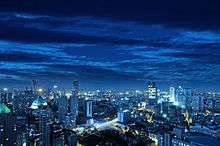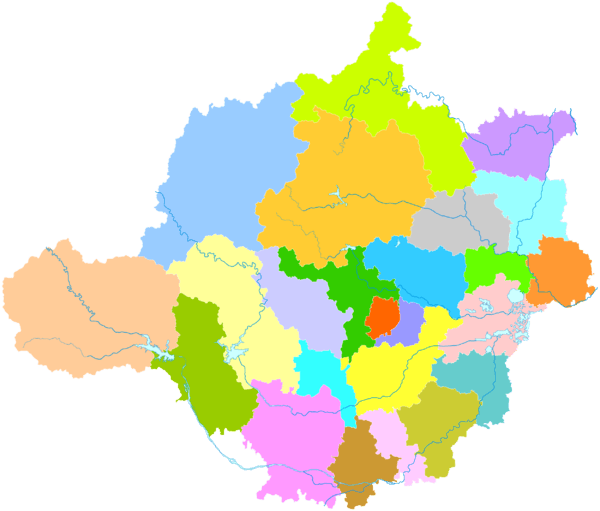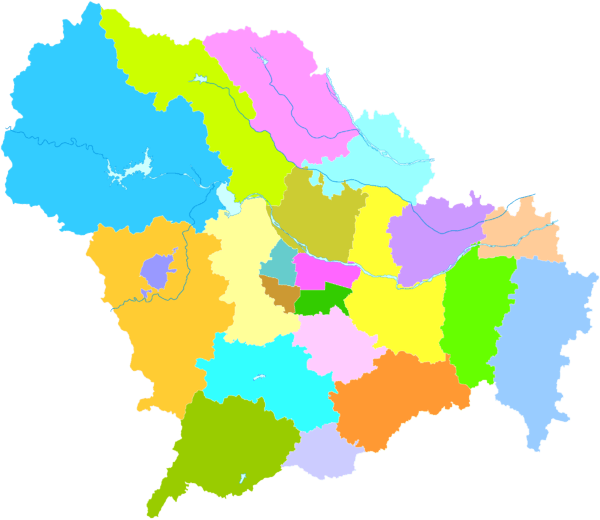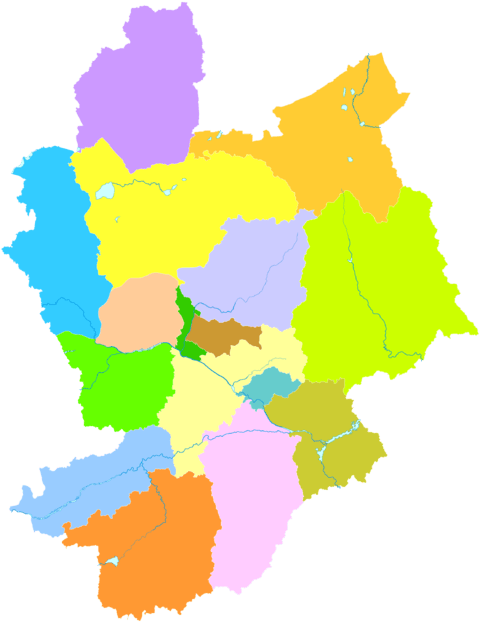Jingjinji
| Jingjinji 京津冀 | |
|---|---|
| Metropolitan region | |
 | |
 Map of Jingjinji in Green | |
| Province | Hebei |
| Municipalities |
Beijing Tianjin |
| Major Prefectural Cities |
Baoding Shijiazhuang Tangshan Cangzhou Langfang Zhangjiakou Chengde |
| Government | |
| • Mayor of Beijing | Wang Anshun |
| • Mayor of Tianjin | Huang Xingguo |
| • Governor of Hebei | Zhang Qingwei |
| Area | |
| • Metro | 215,870 km2 (83,350 sq mi) |
| Population (2015) | |
| • Metropolitan region | 109,564,000 |
| Time zone | CST (UTC+8) |
| Jingjingji | |||||||
| Chinese | 京津冀 | ||||||
|---|---|---|---|---|---|---|---|
| Hanyu Pinyin | Jīngjīnjì | ||||||
| |||||||
Jingjinji or Jing-Jin-Ji (JJJ), also known as Beijing-Tianjin-Hebei, is the national capital region of China. It is the biggest urbanised region in Northern China that includes an economic region surrounding Beijing, Tianjin, and Hebei, along the coast of the Bohai Sea.[1] This emerging region is rising as a northern metropolitan region rivaling the Pearl River Delta in the south and the Yangtze River Delta in the east.
Economy
Jingjinji has traditionally been involved in heavy industries and manufacturing. Tianjin's strengths have always been in aviation, logistics and shipping. Beijing complements this with strong petrochemical, education and R&D industries. The area is becoming a significant growth cluster for the automobile, electronics, petrochemical sectors, automotive industry, software and aircraft, also attracting foreign investments in manufacturing and health services.[2][3]
The Chinese central government has made it a priority to integrate all the cities in the Bohai Bay rim and foster economic development. This includes building an advanced communications network, better highways, increased education and scientific resources as well as tapping natural resources off the Bohai rim.[4]
In recent decades, petroleum and natural gas deposits have been discovered in Jingjinji coast Bo Hai.
Major cities
Jingjinji includes Beijing, Tianjin, and Hebei province. Major cities in these municipalities and provinces include:
| City | Pinyin | Population (2010) | Image | Information | City Map |
|---|---|---|---|---|---|
| Beijing 北京 |
Běijīng | 19,612,368 |  |
Beijing is a metropolis in northern China and the capital of the People's Republic of China. Governed as a municipality under direct administration of the central government. Beijing is China's second largest city after Shanghai, with more than 17 million people in Beijing's area of jurisdiction. |  |
| Tianjin 天津 |
Tiānjīn | 12,938,224 |  |
The third largest city of the People's Republic of China in terms of urban population. Administratively it is one of the four municipalities that have provincial-level status, reporting directly to the central government. Also, its urban land area is the third largest in China, ranked only after Beijing and Shanghai. |  |
| Baoding 保定 |
Bǎodìng | 10,029,197 | |
 | |
| Shijiazhuang 石家庄 |
Shíjiāzhuāng | 9,547,869 |  |
 | |
| Tangshan 唐山 |
Tángshān | 7,577,284 |  |
Tangshan, a coastal city along the Bohai Bay and neighboring Beijing and Tianjin, is a prefecture-level city in Hebei Province, People's Republic of China. Its GDP has surpassed 612.12 billion Yuan in 2013,[5] ranked the 1st of Hebei Province and 19th of Mainland China. It is also known for the 1976 Tangshan earthquake, 7.5 on the Richter scale which flattened the city. |  |
| Cangzhou 沧州 |
Cāngzhōu | 7,134,053 |  |
 | |
| Langfang 廊坊 |
Lángfāng | 4,358,839 |  |
 | |
| Zhangjiakou 张家口 |
Zhāngjiākǒu | 4,345,491 |  |
 | |
| Chengde 承德 |
Chéngdé | 3,473,197 | |
 |
Transportation
Air
Major airports
- Beijing Capital International Airport
- Beijing Daxing International Airport (u/c)
- Tianjin Binhai International Airport
- Shijiazhuang Zhengding International Airport
Regional airports
- Beijing Nanyuan Airport
- Tangshan Sannühe Airport
- Handan Airport
- Qinhuangdao Beidaihe Airport
- Zhangjiakou Ningyuan Airport
- Xingtai Dalian Airport
- Chengde Airport
Road
There are many major highways servicing the routes within Jingjinji area. This includes the following expressways:
- Jingjintang Expressway, from Beijing, through Tianjin's urban area, to Binhai / TEDA
- Jinghu Expressway, from Jinjing Gonglu Bridge to Shanghai (together with Jingjintang Expressway, this is the expressway from Beijing to Shanghai)
- Jingshen Expressway, through Baodi District on its way from Beijing to Shenyang
- Tangjin Expressway, from Tanggu District, Tianjin, to Tangshan, Hebei -- known in Tianjin as the Jintang Expressway
- Baojin Expressway, from Beichen District, Tianjin, to Baoding, Hebei -- known in Tianjin as the Jinbao Expressway
- Jinbin Expressway, from Zhangguizhuang Bridge to Hujiayuan Bridge, both within Tianjin
- Jinji Expressway, from central Tianjin to Jixian County
The following six China National Highways pass through Tianjin:
- China National Highway 102, through Ji County, Tianjin on its way from Beijing to Harbin
- China National Highway 103, from Beijing, through Tianjin's urban area, to Binhai
- China National Highway 104, from Beijing, through Tianjin, to Fuzhou
- China National Highway 105, from Beijing, through Tianjin, to Macau
- China National Highway 112, circular highway around Beijing, passes through Tianjin
- China National Highway 205, from Shanhaiguan, Hebei, through Tianjin, to Guangzhou
Planned road
High-speed rail
Intercity high-speed rail lines
Other high-speed rail lines
- Beijing-Shanghai High-Speed Railway
- Beijing–Shijiazhuang High-Speed Railway
- Tianjin–Qinhuangdao High-Speed Railway
High-speed rail lines planned or under construction
Suburban railway
Metro systems
Light rail
See also
References
- ↑ Johnson, Ian (July 19, 2015). "In China, a Supercity Rises Around Beijing". New York Times.
- ↑ Regional Definition: Bohai Sea Unep.Org Retrieved 2010-01-09
- ↑ Tianjin at a Glance uschina.org Retrieved 2010-01-09
- ↑ Gain a strategic advantage in the Bohai Bay region sdic.com.cn 2007-06-11 Retrieved 2010-01-16
- ↑ 2013年唐山完成地區生產總值6121.2億元 http://ts.yzdsb.com.cn/system/2014/03/10/013620031.shtml
Coordinates: 38°42′N 118°6′E / 38.700°N 118.100°E